Freshwater edible aquatic plants, SE Asia
Introduction
The cultivation and consumption of edible cultivated freshwater
macrophytes and their impact on food security has long been
unrecognised and under-recorded in both the scientific and grey
literature. In a geographical context they have largely been
unrecognised outside South and Southeast Asia where for centuries
they have provided millions of often lower income communities with a
low cost, nutritious foodstuff for both themselves and also their
associated livestock
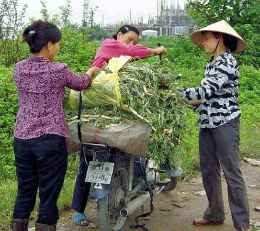 including cultured fish.
Freshwater macrophytes are often used to recycle “waste” nutrients
and also provide significant employment and incomes. It could quite
rightly be said that freshwater aquatic macrophytes (FAMs) are the
“most forgotten form of freshwater aquatic food production” as they
continually remain unrecorded in most government and (inter)
national agriculture and/or aquaculture statistics and planning
documents, despite their significant contribution to food production
and nutrient recycling. In terms of the global aquaculture
development community the range and scale of cultivated edible
aquatic plants production is little known or practised outside South
and Southeast Asia, and is rarely taught in the curricula or
addressed in the research agenda of the major academic aquaculture
and agriculture or international non-government research
organisations (INGOs).
including cultured fish.
Freshwater macrophytes are often used to recycle “waste” nutrients
and also provide significant employment and incomes. It could quite
rightly be said that freshwater aquatic macrophytes (FAMs) are the
“most forgotten form of freshwater aquatic food production” as they
continually remain unrecorded in most government and (inter)
national agriculture and/or aquaculture statistics and planning
documents, despite their significant contribution to food production
and nutrient recycling. In terms of the global aquaculture
development community the range and scale of cultivated edible
aquatic plants production is little known or practised outside South
and Southeast Asia, and is rarely taught in the curricula or
addressed in the research agenda of the major academic aquaculture
and agriculture or international non-government research
organisations (INGOs).
Edwards (1980), estimated that there
were more than 40 species of edible freshwater aquatic macrophytes
(FAMs), of which around 25 % either are already being cultivated for
food at a scalable level or have the potential to be developed into
commercially viable cultivation species. In terms of their genetic
improvement, and species selection for improvements in growth
performance, productivity, phytoremediation of waste water and even
disease resistance, despite the significant translocation of
germplasm between countries or regions over the last 600 years,
there is little either in the research literature or at the grass
roots production level to indicate selective breeding programs,
and/or selection or genetic modification towards improved strains
occurring. However, owing to their scale and their importance
particularly in Southeast Asia, FAMs can be considered a key
tropical/sub-tropical cultivatable crop which can contribute
sustainable food production in developing countries in the future in
a financially viable and environmentally responsible way.
Variety of edible aquatic plants
Aquatic plants are plants that have adapted to living in aquatic environments (saltwater or freshwater). They are also referred to as hydrophytes or macrophytes. These plants require special adaptations for living submerged in water, or at the water’s surface. The following aquatic plants are the most common used as a substitute of food in Asia.
Water spinach or morning glory
 Water spinach is a semiaquatic, tropical plant grown as a
vegetable for its tender shoots and leaves. It is found throughout
the tropical and subtropical regions of the world. This plant is
known as river spinach, water morning glory, water convolvulus,
Chinese spinach, Chinese Watercress, Chinese convolvulus, swamp
cabbage or kangkong. Water spinach grows in water or on moist soil.
Its stems are 2–3 metres or more long, rooting at the nodes and they
are hollow and can float. The leaves are arrow head-shaped 5–15 cm
long and 2–8 cm broad. Water Spinach is a common ingredient in
Southeast Asian dishes. Stir-fried water spinach is a popular
vegetable dish in Southeast Asia (source: text
Ashwini R., photo
Eric in SF /CC
BY-SA 4.0 | Water Spinach). Morning glory was found to be
by far the most common aquatic plants in the cities which were
considered in this case.
Water spinach is a semiaquatic, tropical plant grown as a
vegetable for its tender shoots and leaves. It is found throughout
the tropical and subtropical regions of the world. This plant is
known as river spinach, water morning glory, water convolvulus,
Chinese spinach, Chinese Watercress, Chinese convolvulus, swamp
cabbage or kangkong. Water spinach grows in water or on moist soil.
Its stems are 2–3 metres or more long, rooting at the nodes and they
are hollow and can float. The leaves are arrow head-shaped 5–15 cm
long and 2–8 cm broad. Water Spinach is a common ingredient in
Southeast Asian dishes. Stir-fried water spinach is a popular
vegetable dish in Southeast Asia (source: text
Ashwini R., photo
Eric in SF /CC
BY-SA 4.0 | Water Spinach). Morning glory was found to be
by far the most common aquatic plants in the cities which were
considered in this case.
Watercress
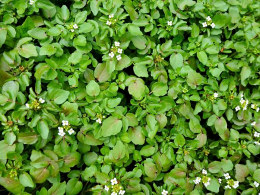 Watercress is an aquatic plant species with the botanical name Nasturtium officinale. Watercress is a rapidly growing, aquatic
or semi-aquatic, perennial plant native to Europe and Asia and one of the oldest known leaf vegetables consumed by humans.
It is a rapidly growing, aquatic or semi-aquatic, perennial plant native to Europe and Asia and one of the oldest known leaf
vegetables consumed by humans. The hollow
stems of watercress are floating and the leaves are pinnately
compound. Small, white and green flowers are produced in clusters.
In some regions, watercress is regarded as a weed, in other regions
as an aquatic vegetable or herb. Watercress has been grown in many
locations around the world. Watercress contains significant amounts
of iron, calcium, iodine, manganese and folic acid. Because it is
relatively rich in vitamin C, watercress was suggested by English
military surgeon John Woodall (1570–1643) as a remedy for scurvy.
(source: text Ashwini R.,
photo
Wendell Smith /CC
BY 2.0 | Watercress With Flowers)
Watercress is an aquatic plant species with the botanical name Nasturtium officinale. Watercress is a rapidly growing, aquatic
or semi-aquatic, perennial plant native to Europe and Asia and one of the oldest known leaf vegetables consumed by humans.
It is a rapidly growing, aquatic or semi-aquatic, perennial plant native to Europe and Asia and one of the oldest known leaf
vegetables consumed by humans. The hollow
stems of watercress are floating and the leaves are pinnately
compound. Small, white and green flowers are produced in clusters.
In some regions, watercress is regarded as a weed, in other regions
as an aquatic vegetable or herb. Watercress has been grown in many
locations around the world. Watercress contains significant amounts
of iron, calcium, iodine, manganese and folic acid. Because it is
relatively rich in vitamin C, watercress was suggested by English
military surgeon John Woodall (1570–1643) as a remedy for scurvy.
(source: text Ashwini R.,
photo
Wendell Smith /CC
BY 2.0 | Watercress With Flowers)
Lotus
 Lotus
Lotus is native
to tropical Asia and Queensland, Australia. It is commonly
cultivated in water gardens. It is also the national flower of India
and Vietnam. The roots of lotus are planted in the soil of the pond
or river bottom, while the leaves float on top of the water surface
or are held well above it. The flowers are usually found on thick
stems rising several centimeters above the leaves. The plant
normally grows up to a height of about 150 cm and a horizontal
spread of up to 3 meters. An individual lotus can live for over a
thousand years. The flowers, seeds, young leaves, and roots are all
edible. In Asia, the petals are sometimes used for garnish, while
the large leaves are used as a wrap for food. In South Indian
states, the Lotus Stem is sliced, marinated with salt to dry and the
dried slices are fried and used as a side dish (source: text
Ashwini R., photo
Loren Kerns /CC
BY 2.0 | Lotus Root Slices).
Lotus
Lotus is native
to tropical Asia and Queensland, Australia. It is commonly
cultivated in water gardens. It is also the national flower of India
and Vietnam. The roots of lotus are planted in the soil of the pond
or river bottom, while the leaves float on top of the water surface
or are held well above it. The flowers are usually found on thick
stems rising several centimeters above the leaves. The plant
normally grows up to a height of about 150 cm and a horizontal
spread of up to 3 meters. An individual lotus can live for over a
thousand years. The flowers, seeds, young leaves, and roots are all
edible. In Asia, the petals are sometimes used for garnish, while
the large leaves are used as a wrap for food. In South Indian
states, the Lotus Stem is sliced, marinated with salt to dry and the
dried slices are fried and used as a side dish (source: text
Ashwini R., photo
Loren Kerns /CC
BY 2.0 | Lotus Root Slices).
Water caltrop
 Water caltrop is any of three extant species. The species are
floating annual aquatic plants, growing in slow-moving water up to 5
meters deep, native to warm temperate parts of Eurasia and Africa.
The plant is also called water chestnut, buffalo nut, bat nut,
devil pod, ling nut and singhara. They bear ornately shaped fruits.
Each fruit contains a single very large starchy seed. In India and
Pakistan it is known as singhara or paniphal and is widely
cultivated in fresh water lakes. The fruits are eaten raw or boiled.
When the fruit has been dried, it is ground to a flour called
singhare ka atta. Singhare ka atta is used in many religious rituals
and can be consumed as a phalahar diet on the Hindu fasting days,
the navratas. Water caltrop has been an important food for worship
as prayer offerings since the Chinese Zhou Dynasty. The Chinese
Herbal Medicine Summary indicates that water caltrop can help fever
and drunkenness (source: text
Ashwini R., photo
TheDarkCurrent /CC
BY-SA 3.0 | Water Caltrop Seeds).
Water caltrop is any of three extant species. The species are
floating annual aquatic plants, growing in slow-moving water up to 5
meters deep, native to warm temperate parts of Eurasia and Africa.
The plant is also called water chestnut, buffalo nut, bat nut,
devil pod, ling nut and singhara. They bear ornately shaped fruits.
Each fruit contains a single very large starchy seed. In India and
Pakistan it is known as singhara or paniphal and is widely
cultivated in fresh water lakes. The fruits are eaten raw or boiled.
When the fruit has been dried, it is ground to a flour called
singhare ka atta. Singhare ka atta is used in many religious rituals
and can be consumed as a phalahar diet on the Hindu fasting days,
the navratas. Water caltrop has been an important food for worship
as prayer offerings since the Chinese Zhou Dynasty. The Chinese
Herbal Medicine Summary indicates that water caltrop can help fever
and drunkenness (source: text
Ashwini R., photo
TheDarkCurrent /CC
BY-SA 3.0 | Water Caltrop Seeds).
Water chestnut
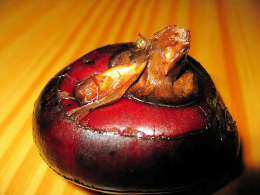 The Water chestnut or Chinese water chestnut is a grass-like
sedge native to Asia, Australia, tropical Africa and various islands
of the Pacific and Indian Oceans. It is widely grown in many
countries for its edible corms. The water chestnut is actually not a
nut at all, but an aquatic vegetable that grows in marshes,
underwater in the mud. It has tube-shaped, leafless green stems that
grow to about 1.5 metres. The small, rounded corms have a crisp
white flesh and can be eaten raw, slightly boiled or grilled, and
are often pickled or tinned. They are a popular ingredient in
Chinese dishes. In China, they are most often eaten raw, sometimes
sweetened. Raw water chestnuts are slightly sweet and very crunchy.
Boiled water chestnuts have a firm and slightly crunchy texture with
a flavour that is very mild and slightly nutty. Water chestnuts are
often combined with bamboo shoots, coriander, ginger, sesame oil and
snow peas. They are often used in noodle or rice dishes (source:
text Ashwini R.,
photo
Joscha Feth /Public
Domain | Water Chestnut Corm).
The Water chestnut or Chinese water chestnut is a grass-like
sedge native to Asia, Australia, tropical Africa and various islands
of the Pacific and Indian Oceans. It is widely grown in many
countries for its edible corms. The water chestnut is actually not a
nut at all, but an aquatic vegetable that grows in marshes,
underwater in the mud. It has tube-shaped, leafless green stems that
grow to about 1.5 metres. The small, rounded corms have a crisp
white flesh and can be eaten raw, slightly boiled or grilled, and
are often pickled or tinned. They are a popular ingredient in
Chinese dishes. In China, they are most often eaten raw, sometimes
sweetened. Raw water chestnuts are slightly sweet and very crunchy.
Boiled water chestnuts have a firm and slightly crunchy texture with
a flavour that is very mild and slightly nutty. Water chestnuts are
often combined with bamboo shoots, coriander, ginger, sesame oil and
snow peas. They are often used in noodle or rice dishes (source:
text Ashwini R.,
photo
Joscha Feth /Public
Domain | Water Chestnut Corm).
Significance of aquatic food products in SE Asia
Aquatic food products are important in the diets of people of the SE Asian region and include a variety of vegetables, fish and other animals. The origins of farming aquatic animals in the Region are quite likely to be urban since until recently most rural areas of Asia where people value fish and edible aquatic plants as food had access to abundant natural stocks of both without the needs to cultivate. The graph below depicts an example in Thot Chrum, a community in Cambodia, about the role of aquatic plant production in livelihoods.
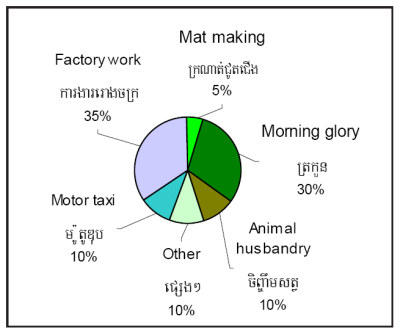
Urbanisation in SE Asia is occurring most rapidly
in larger cities typically situated on the floodplains of large
rivers. Limited drainage infrastructure and formal sanitation
serving such cities, together with the extraction of fill from
surrounding areas for construction and flood defences has frequently
resulted in peri-urban wetlands that become both de facto waste
treatment and food production systems. Such peri-urban wetlands have
been important food production centres and appear to have enduring
importance to the livelihoods of lower income poor people. By the
same token these peri-urban lagoons, canals and ponds commonly
provide the only accessible means of disposing of human excreta and
therefore have much broader importance to urban communities.
Although attention has been drawn to the benefits 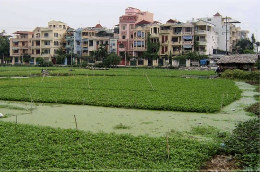 of such wetlands,
generally their value is unmeasured and impacts of contamination
from wastes, changing access and urbanisation unknown.
of such wetlands,
generally their value is unmeasured and impacts of contamination
from wastes, changing access and urbanisation unknown.
Informed
policy and management of peri-urban zones in Asia is handicapped by
a lack of informed and balanced debate regarding how stakeholders
value aquatic production systems in terms of public health risks,
food availability and livelihoods. The lack of information about
these systems contrasts with an extensive knowledge base on solid
waste and wastewater reuse in agriculture.
The dynamic nature
of peri-urban areas require scientists, planners and policy makers
to deal with rapid and often destructive changes to Periurban
Aquatic Food Production Systems PAFPS whilst attempting to meet the
challenge of meeting urban populations basic needs.
Freshwater
edible aquatic plants or macrophyte production was found through the
EC funded PAPUSSA project to be a significant food production sector
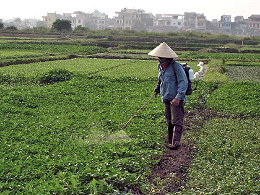 employing thousands across the value chain, and supplying fresh food
to millions of citizens in 4 SE Asian cities, this by primarily
recycling and reusing nutrients from urban wastewater. The EC funded
PAPUSSA (Production in Aquatic Peri Urban Systems in SE Asia)
project (2003-2006) initially chose Hanoi and HCMC in Vietnam, Phnom
Penh in Cambodia, and Bangkok, to study and evaluate the importance
of periurban aquaculture production in these 4 SE Asian cities. It
was found contrary to our original research hypotheses suggesting
the importance of periurban fish production, rather it was the
production, sale and consumption of four species of edible aquatic
plants which predominated to the level of supplying millions of
urban citizens with a fresh daily supply of nutritious food, as well
as providing thousands of individuals, often at household level
income earning activities across the value chain.
employing thousands across the value chain, and supplying fresh food
to millions of citizens in 4 SE Asian cities, this by primarily
recycling and reusing nutrients from urban wastewater. The EC funded
PAPUSSA (Production in Aquatic Peri Urban Systems in SE Asia)
project (2003-2006) initially chose Hanoi and HCMC in Vietnam, Phnom
Penh in Cambodia, and Bangkok, to study and evaluate the importance
of periurban aquaculture production in these 4 SE Asian cities. It
was found contrary to our original research hypotheses suggesting
the importance of periurban fish production, rather it was the
production, sale and consumption of four species of edible aquatic
plants which predominated to the level of supplying millions of
urban citizens with a fresh daily supply of nutritious food, as well
as providing thousands of individuals, often at household level
income earning activities across the value chain.
Aquatic plants production in cities in South-East Asia
Mainly four edible freshwater aquatic plants are cultivated, sold,
and consumed on a huge commercial scale in 4 SE Asian cities
Asian cities, such as Hanoi, Ho Chi Minh City (HCMC), Phnom Penh and
Bangkok, primarily recycling nutrients from urban waste water. Ipomea
aquatica and Neptunia
 oleracea are cultivated 12 months per year in
Bangkok, Phnom Penh and HCMC. Whilst in the more seasonal climate of
Hanoi they are grown in summer months and then water cress and water dropwort rotated on same plots in their winters. Typically morning
glory and water mimosa are grown in wastewater irrigated, 0.5-2.0
hectare former, periurban rice plots, and harvested every 25-30 days
for 12 months of the year in HCMC. Whilst in Phnom Penh lower income
families living on the edge of a large periurban wetland/lake fed by
80% of the city’s urban waste water cultivate significant volumes of
water morning glory and water mimosa. Productivities range from
15-50 MT per hectare per year, most of which is washed and bundled
up and then transported by motorbike to local urban markets early
each morning to be sold to millions of urban consumers. These
aquatic plants are rich in minerals especially iron, and form the
basis for millions of urbans dwellers noodle and other soup dishes.
oleracea are cultivated 12 months per year in
Bangkok, Phnom Penh and HCMC. Whilst in the more seasonal climate of
Hanoi they are grown in summer months and then water cress and water dropwort rotated on same plots in their winters. Typically morning
glory and water mimosa are grown in wastewater irrigated, 0.5-2.0
hectare former, periurban rice plots, and harvested every 25-30 days
for 12 months of the year in HCMC. Whilst in Phnom Penh lower income
families living on the edge of a large periurban wetland/lake fed by
80% of the city’s urban waste water cultivate significant volumes of
water morning glory and water mimosa. Productivities range from
15-50 MT per hectare per year, most of which is washed and bundled
up and then transported by motorbike to local urban markets early
each morning to be sold to millions of urban consumers. These
aquatic plants are rich in minerals especially iron, and form the
basis for millions of urbans dwellers noodle and other soup dishes.